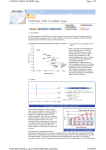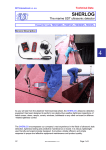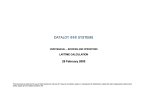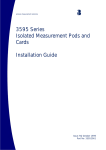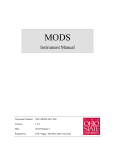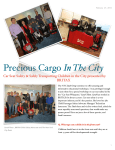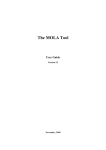Download The SDT Sherlog Maritime Global Solutions -- pdf 350K
Transcript
1 The SDT Sherlog maritime global solutions Ultrasonics in weather tightness and leak detection Click on any of these main chapters to access them directly 1. 2. 3. 4. 5. 6. 7. Home Page What’s New? The SDT Sherlog Product Line Hatch Cover Tightness Testing Rules & Regulations Training & Certification Contact Us 1. The SDT Sherlog Maritime Global Solutions For more than 25 years, SDT International has developed state-of-the-art ultrasonic and non-ultrasonic high quality detection and measurement instruments. Among the many fields of applications, it has built up a recognized large expertise in ultrasonic leak detection as well as tightness testing. Understanding and meeting the needs and expectations of the many different groups of users is trivial and probably the least you should expect from a manufacturer like SDT International. Another thing is to evolve with those versatile needs, be able to anticipate them and then develop the appropriate dedicated technologies, tools and services. An important illustration of this corporate attitude is the understanding of the specific needs of the marine industry and particularly the great importance of tightness on board (whether water-, weather- or gas- tightness integrity) and the devastating and costly consequences of undetected leaks or water ingress in cargo holds. To meet these issues, SDT International has developed specifically a global solution putting together a dedicated line of instruments and services focusing on maritime applications, the SHERLOG line. It combines with a new comprehensive theoretical and practical ultrasonic training in ultrasonics, rules and regulations, hatch cover designs and deficiencies as well as ultrasonic tightness procedures (go to 6.Training & Certification) Successful candidates then receive a Certificate of Qualification in order to certify and qualify surveyors and operators to that end. 2 Frequent users of the SDT Sherlog program do consider that it probably offers the marine industry the single most efficient and state-of–the art products for a versatile number of maritime applications. 2. What’s New? Flash news: New training program : http://www.sdt.be/12sherlogPDF/training.pdf Updated list of the marine certified Surveyors / Operators : http://www.sdt.be/pdf/certified.pdf 3 3. The SDT Sherlog Product Line Sherlog: The flexible multifunctional solution for marine applications The Sherlog is built around the SDT worldwidely used ultrasonic detection capabilities and it features a particularly accurate and sensitive internal airborne ultrasonic sensor. Numerous onboard and offshore needs such as measuring physical parameters (ultrasounds, audible noise, temperature, rotation and linear speed, flow) are covered. The Sherlog is ergonomically designed and user-friendly. It is handheld and easily controlled by only eight key touch keys. Its generous Liquid Crystal Display and is protected from harsh handling and environment by a strong extruded aluminium outer shell and “anti-shock” rubber housing. Easy to use, the Sherlog is “intelligent”. It recognises external sensors upon connection and automatically switches to the appropriate parameters and measuring mode. SDT Sherlog: Why you should be using it The only system of its kind to be Type Approved by Class Strong, shock resistant for use in harsh maritime conditions The only instrument to boast a tamper-proof HCO survey routine, with data logging and data download for enhanced reporting All measurements in dBµV Can be used for RoRo and dry dock operations Gives indication about compression between compression bar and rubber packing The only method that quickly pinpoints small leaks and areas that lack compression Allows quick and easy testing without assistance from ship’s crew Can be used for weathertightness and air/gas tightness Can be used in ports forbidding hose testing to avoid pollution washed away from the deck. Save time and trouble ! One-man operation Can be carried out without interfering with ship operations Reduces idle time in port Can be carried out in sub-zero temperatures Can be used in loaded holds, even with water-sensitive cargoes. 4 For all these reasons, the SDT Sherlog offers the most complete, dedicated solution for maritime applications. Who should be using it? Classification Societies and P&I Clubs Class service suppliers Surveyors Ship yards and repair yards Ship crews. To receive the new SDT Sherlog 6 page colour folder just contact [email protected] The SDT Sherlog Line The SDT Sherlog TA Designed to perform nondestructive weather tightness inspections of hatch covers, doors, ramps, ramp covers, windows, bulkheads or any other on-board or offshore applications. Among its many features the SHERLOG TA offers a large memory capacity to digitally process, display and output data in standard protocol formats. Moreover, the SHERLOG TA offers a unique software routine –specifically for ultrasonic hatch cover tightness testing - that memorises, logs and downloads to PC all measured data for detailed and accurate reporting. The SDT SHERLOG TA kit contains: 1 Sherlog Ultrasonic Detector with battery and rubber protection 1 battery loader for detector's battery; 240V/European plug 1 Sherlog 8 multi-setting ultrasonic multi-transmitter with battery and leather case 1 spare battery for the multi-transmitter 1 battery loader adapter for Sherlog-8 1 battery loader for Sherlog-8; 240V/European plug 1 820 mm flexible rod with a 14 mm external sensor for the Sherlog detector 1 noise isolating headphone set 130 dB 1 cable RS232 Stewart - Sub D9 female; L 1,5m (for connection to PC) 1 3,5" diskette with software for data transfer to PC. Miscellaneous: 1 Y plug connector 1 shoulder straps for Sherlog detector and 1 for the multi-transmitter 4 precision indicators for Sherlog detector (threaded tip, rubber tip, tubes) 1 screw driver for battery cover of multi-transmitter 1 technical and user manual 5 1 Calibration Certificate 1 copy of the different Class Type Approvals 1 carrying suitcase + foam inlay. The SDT SHERLOG S Also designed for ultrasonic tightness testing, the SHERLOG S is perfect for routine monitoring and tightness checks when no memorization is required, nor a Type Approved instrument required. The Sherlog S is equally multifunctional and adapted for many different mechanical applications. Robust and versatile, it also detects small pressure and vacuum leaks, even in noisy shipyard environments. It is particularly good at trending the condition and the wear-and-tear of rotating machinery components as bearings, gears or couplings –without dismantling them. It excels as well for assessing the condition of pumps, valves, steam traps and turbines. Last but not least it is a perfectly appropriated instrument for detecting electrical short circuits, sparks or corona discharges. The Sherlog S kit contains almost the same components as the Sherlog TA, without the memory capacity and survey data logging options. The SDT SHERLOG S kit contains: 1 Sherlog Ultrasonic Detector with battery and rubber protection 1 battery loader for detector's battery; 240V/European plug 1 Sherlog 8 ultrasonic multi-transmitter with battery and leather case 1 battery loader for Sherlog-8; 240V/European plug 1 820 mm flexible rod with a 14 mm external sensor for the Sherlog detector 1 noise isolating headphone set,130 dB 1 cable RS232 Stewart - Sub D9 female; L 1,5m (for connection to PC) Miscellaneous: 1 shoulder straps for Sherlog detector and 1 for the multi-transmitter 4 precision indicators for Sherlog detector (threaded tip, rubber tip, tubes) 1 screw driver for battery cover of multi-transmitter 1 technical and user manual 1 Calibration Certificate 1 carrying suitcase + foam inlay. 6 4. Hatch Cover Tightness Testing 3 steps towards reducing claims Water-damaged cargo remains a pressing problems. Owners, charterers, P & I Clubs and insurers are faced with several hundred million dollars of water damage claims a year, not counting missed deadlines and serious disruption to client operations. Now ultrasonic tightness testing can dramatically improve the n° 1 cause for claims each year – simply, accurately and reliably! 1. Nothing works like ultrasonic Ultrasonic is more than just another form of testing tightness. It offers a complete, global solution with unheard-of accuracy and reliability. Accuracy that has received Classification Society Type Approval. Hose and chalk tests demonstrate whether or not there is contact between the rubber packing and compression bar but give no indication of the actual compression. Once at sea, it is often too late to see the shortcomings of this method. Only ultrasonic testing can show you when you have the required or acceptable compression. 2. Ultrasonic testing is custom-made for maritime applications Nothing beats ultrasonic testing for simplicity and pinpoint accuracy: • Totally reliable, accurate – and repeatable • No need for water or for complicated operations • Ultrasonic testing slashes the time needed to test the condition of hatch covers, RoRo doors, bulkheads or windows. • Ensures that hatch covers offer true cargo worthiness and prevent water ingress • Hand-held operation by 1 man. • Reduces costly idle time in ports • Easy, fast pre-load inspections. 3. A global solution: instrument, training and certification The industry recognition is not just for the SDT SHERLOG line. Only Sherlog comes with the SDT-IMCS training programme. Trainee operators are given, as required by Class and the Industry, comprehensive theoretical and onboard practical training in ultrasonics, rules and regulations, hatch cover designs and deficiencies as well as ultrasonic testing procedures. 7 Successful candidates receive a Certificate of Qualification and are added to the growing list of Certified Surveyors. Significantly, the training programme is approved by Class and accredited by the Nautical Institute. For further details go to 6. Training & certification. So not only is the Sherlog TA a superior testing method, it is also a comprehensive programme that led to a new standard in the marine industry. How does ultrasonic testing work? The principle for ultrasonic testing is remarkably simple. An ultrasonic transmitter is placed in the hold (empty or with cargo) and emits ultrasound waves. The hatch cover is then closed, fully cleated and battened. The surveyor or operator then uses the Sherlog ultrasonic detector to listen from the outside and pick up all “leaking” ultrasonic sounds that pass through the sealing arrangements, vents and/or cracks. Ultrasonic testing is far more accurate than other testing methods, enabling operators and surveyors to pinpoint leaks that are a problem – or are likely to become one. When combined with computer systems, ultrasonic testing offers the maritime world a complete tamper-free solution. Surveyed data can be memorised for analysis and the Data downloaded to PC for fast, reliable and documented reporting. 8 5. Rules & Regulations The IACS Unified Requirement U.R.Z17 The International Association of Classification Societies has set the procedure that sets the basic standards for qualifying service suppliers. Firms, surveyors and operators more specifically concerned are those • Engaged in tightness testing of hatches with ultrasonic equipment • Engaged in the examination of Ro-Ro ships bow, stern, side and inner doors. The U.R. Z 17 specifically highlights: • Training of personnel (§ 4.2.2) • Personnel records: (§ 4.2.4) • Operators required qualifications / theoretical and practical onboard training (Annex 1, § 2.2) • Equipment, which is to be type approved by the Society (Annex 1, § 2.3). The full details can be found on the www.iacs.org.uk under “Unified Requirements” / “Z: Survey and Certification” / “Z17: Procedural Requirements” These requirements, rules and procedures are to day largely accepted and applied by the marine industry. The Class approvals for SHERLOG TA Following the IACS requirements SDT International had its new Sherlog TA formally Type Approved. Currently it holds Class Approval Certificates from ABS, DNV, Hellenic RS, Lloyd’s RS and Russian MRS. Other similar approvals are in progress. The Sherlog TA is currently the only such equipment for ultrasonic testing that complies fully with Class requirements and to have been granted such Approvals. Calibration requirements Classification Societies require the ultrasonic equipment to hold a valid certificate of calibration. This operation is only performed at SDT International plant in Brussels. The issued certificate is valid during two years. At expiry, the instrument is to be re-calibrated by SDT in order to issue a renewed certificate. 9 6. Training and Certification It is a recognised need to provide Marine Surveyors as well as maritime concerned professionals with a specific in-depth theoretical and practical training before performing ultrasonic tightness testing of hatches or any onboard device required to be tight. As tremendous amounts of money are paid every year to compensate wet damage claims, accurately assessing hatch cover tightness has become essential. So Class and most principals now consider training mandatory. The SDT training course program SDT International together with Walter Vervloesem, marine surveyor and currently chairman of the Belgian Branch of the Nautical Institute, conceived a completely new training program to fully comply with the Class requirements and the growing needs of the industry. Accreditation The SDT-IMCS training course on “Ultrasonic Tightness Testing” as been approved by several Classification Societies and accredited by the Nautical Institute. Language The complete training, as well as the CD-Rom syllabus, the documentation and the written examination is in English. All trainees are therefore expected to have a good working knowledge of that language. The program It gives surveyors and operators a complete insight of ultrasonic tightness testing. The course covers: • Basics about ultrasounds • Using type approved ultrasonic equipment • Applicable rules, conventions and procedures • Claims as a result of wetting damage • Inspection of hatch covers • Hatch cover vocabulary, design features and frequently found defects • Types and designs of Ro-Ro equipment • Different testing methods (advantages and drawbacks) • Onboard practical ultrasonic tightness test • Data logging and transfer of surveyed data to PC • Reporting. Each trainee exercises and is trained on an individual SHERLOG TA instrument provided by SDT during the session. The course is concluded by an open-book written examination covering: • Ultrasounds and testing procedures • Hatch cover vocabulary • Hatch cover defects • Ultrasonic hatch cover inspection. 10 Candidates are expected to obtain a minimum of 50% mark on each exam module and an overall mark of at least 60% in order to be qualified and receive their Certificate of Qualification. Presentation The complete course comes in the form of a Syllabus covering all the modules and subjects of the training as well as the recently published book “Hatch Cover Inspection” written by Walter Vervloesem. Certification The successful completion of the training leads to the delivery of a “Certificate of Qualification”, valid for three years. SDT International issues the “Certificates of Qualification” some three weeks after the training session and after assessment of the examination results. The names and coordinates of all newly qualified operators are published in the "List of Qualified US Operators" accessible hereunder: see “List of Certified Operators” Certificate renewal After the three-year period, the qualification of the surveyor must be reassessed, prior to the issuing of a renewed three-year certificate Conditions and registration Training sessions are regularly organised in Belgium as well as different places in the world. For updated information, dates, venues, conditions and registration please contact [email protected] or visit : http://www.sdt.be/12sherlogPDF/training.pdf °°°°°°°°°°°°° 7. Contact us Whatever the question, we are there for any technical or sales requests, please do not hesitate to contact us o o o E.mail: Phone: Telefax: [email protected] +32 2 332.3225 +32 2 376 2707 °°°°°°°°°°°°°°°°°°°°°°°°°°°










